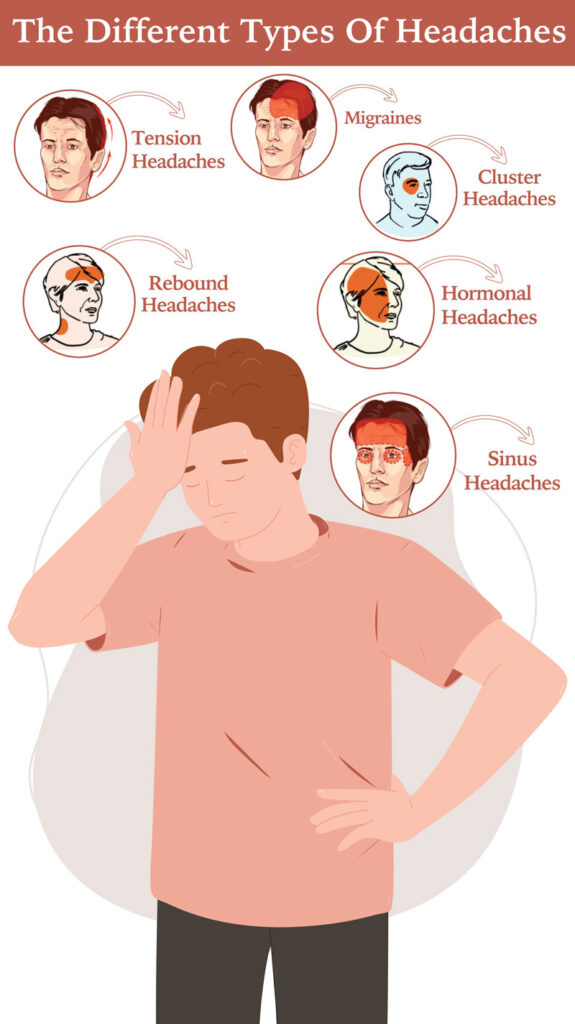Introduction
Headaches are a common condition characterized by pain or discomfort in the head or neck region. They can vary in intensity, duration, and location. Headaches can be classified into different types based on their underlying causes, symptoms, and patterns. A minor inconvenience, headaches can significantly impact one’s quality of life and productivity. Understanding the different types of headaches is essential for proper diagnosis and effective treatment.
In this comprehensive guide, we will explore the various types of headaches, their causes, symptoms, and available treatment options. Let’s dive in and gain a deeper understanding of these troublesome conditions.
1. Tension Headaches
Tension headaches are the most common type experienced by individuals. They are often described as a constant, dull ache on both sides of the head, usually accompanied by muscle tension in the neck and shoulders. Stress, poor posture, anxiety, and inadequate sleep are common triggers for tension headaches. Over-the-counter pain relievers, relaxation techniques, and stress management strategies are commonly recommended for relief.
2. Migraines
Migraines are intense, throbbing headaches that can last from a few hours to several days. They often occur on one side of the head and may be accompanied by symptoms such as nausea, sensitivity to light and sound, and visual disturbances. Migraines are believed to be caused by changes in the brain’s blood flow and chemical imbalances. Identifying triggers, maintaining a headache diary, prescription medications, and lifestyle modifications can help manage migraines effectively.
3. Cluster Headaches
Cluster headaches are excruciatingly painful and typically occur in cyclical patterns, with periods of intense pain followed by remission. They are often described as a burning or piercing sensation behind or around one eye. Cluster headaches are more common in men and can be accompanied by symptoms like nasal congestion, restlessness, and agitation. High-flow oxygen therapy, triptan medications, and preventive treatments are commonly used to manage cluster headaches.

4. Sinus Headaches
Sinus headaches occur when the sinuses become inflamed or infected, leading to a deep, constant pain in the forehead, cheekbones, or bridge of the nose. Symptoms may worsen when bending forward or lying down. Sinus headaches are usually caused by sinusitis or allergies. Over-the-counter pain relievers, nasal decongestants, steam inhalation, and addressing the underlying cause are typical treatment approaches.
5. Rebound Headaches
Rebound headaches, also known as medication-overuse headaches, are caused by excessive use or over-reliance on pain medications. They often occur when the effect of the medication wears off, leading to a cycle of recurring headaches. Breaking the cycle involves gradually reducing medication use under medical supervision and exploring alternative treatments.
Causes and Symptoms
The causes of headaches can vary depending on the type. Common causes include stress, tension, poor posture, lack of sleep, sinus infections, hormonal changes, and medication overuse. Symptoms of headaches may include dull or throbbing pain, pressure or tightness in the head, sensitivity to light or sound, nausea, and in some cases, visual disturbances or dizziness. It is important to note that headaches can have multiple causes, and consulting with a healthcare professional is recommended for proper diagnosis and management.
Treatment Options for Headaches
Treatment options for headaches vary depending on the type and severity of the headache. Over-the-counter pain relievers such as acetaminophen (paracetamol), ibuprofen, and aspirin are commonly used for mild to moderate headaches. For migraines, triptans (such as sumatriptan) and ergotamine derivatives may be prescribed. Preventive medications like beta-blockers, antidepressants, and antiepileptic drugs can be considered for frequent or severe headaches. Non-pharmacological approaches such as relaxation techniques, stress management, regular exercise, and maintaining a consistent sleep schedule may also help alleviate headache symptoms. It is important to consult with a healthcare professional for proper diagnosis and to determine the most appropriate treatment plan for your specific condition.
Conclusion
Understanding the different types of headaches is crucial for effective management and improving quality of life. From tension headaches to migraines, cluster headaches to sinus headaches, and hormonal headaches to rebound headaches, each type has its own causes, symptoms, and treatment options. Consulting with healthcare professionals, such as those at the Kane Hall Barry Headache Center, can provide valuable insights, accurate diagnoses, and personalized treatment plans. By seeking professional guidance, individuals can receive the appropriate care and support needed to address their specific headache concerns and find relief. Remember, proactive management and collaboration with experts are essential steps towards minimizing the impact of headaches and achieving better overall well-being.
Apart from their expertise in headache management, the Kane Hall Barry neurology team offers a wide range of services, including comprehensive neurological evaluations, Diagnostic Testing, personalized treatment plans, and ongoing support for patients with various neurological conditions.






